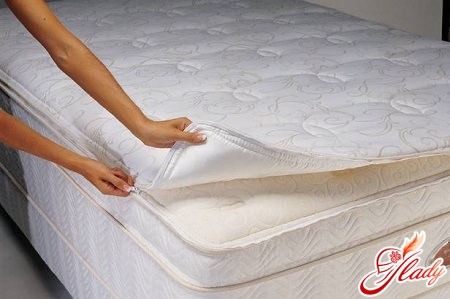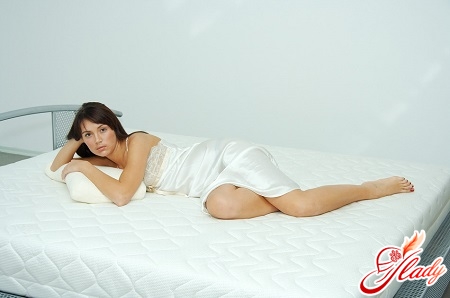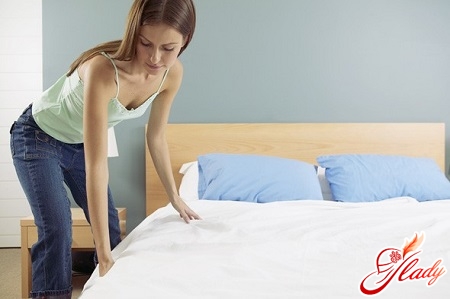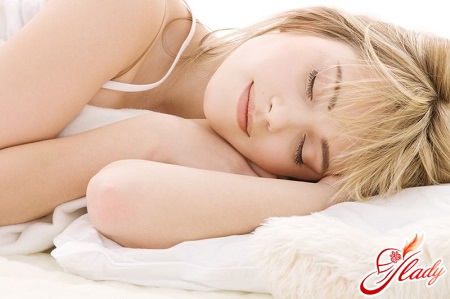
About a third of one's life each personspends in a dream. Just think about this impressive figure! A good sleep is very important for your health and performance. Why, then, do you pay so little attention to the conditions in which you sleep? You buy a car to get to work or give faster. You buy more and more home appliances, so it's easier to prepare food and maintain order in the house. You meticulously choose in the store soft or cabinet furniture - comfortable, high-quality, durable, ergonomic. But you remember the mattress in the last place, at best, after you find in your mail box an advertising leaflet with the catchy inscription "How to choose an orthopedic mattress". Below we will answer this question and tell you what characteristics of the mattress you need to take into account when buying it. Strictly speaking, this article is about how to choose something that does not exist in the world. Yes, yes, we were not mistaken: the expression "orthopedic mattress" is not quite right, it would be more correct to talk about "orthopedic effect" or "anatomical effect". Why?

Orthopedic mattress or orthopedic effect?
About half a century ago, on the wave of revolutionarymedical discoveries and developments, many furniture manufacturers have thought about how to improve their products and gain an advantage over competitors. So the idea of a mattress was born, which would differ from others from a medical point of view. The result of scientific research done in this direction was the so-called orthopedic mattress. However, until now there are no state standards that would allow us to officially qualify certain types of mattresses as orthopedic mattresses. Hence, confusion arises in terms when an ordinary buyer, choosing a mattress, is forced to rely only on advertising of producers who claim that only their products are "the most orthopedic". These orthopedic mattresses are manufactured under the order of an orthopedic doctor, since their purpose is the treatment of diseases of the joints and spine. They are made taking into account the medical indications, features of the physique and parametric data of the future owner. So in the store you get just a hard mass-produced mattress, even if it has an "orthopedic" sticker on it. He can not, for example, cure a bad back or relieve you of joint pain. Therefore, speaking about the merits of the so-called "orthopedic product", it would be more correct to use the expressions "orthopedic effect" and "anatomical effect". Orthopedic effect means the degree of stiffness of the mattress, and the "anatomical effect" implies the ability of the mattress to repeat the contours of the body of a sleeping person. Such products help to relieve fatigue and tension of the spine, providing optimal support throughout the night and reducing the burden on the problem areas of the back. The spine, therefore, is in a position as close as possible to the natural. Orthopedic or anatomical effect can be more or less pronounced, depending on whether or not you pick up the mattress.
Hard, medium or soft?
It is logical that when choosing a mattress, one should take into accountthe weight of the person who will sleep on it. If the sleeper is a subtle person, an overly rigid mattress under his weight will not bend, and the spine will be in a curved state. If the sleeper differs solid physique, too soft mattress just sag. It turns out that in order for the mattress to allow the spine to be in its natural state and repeat the shape of the body, the load should be distributed evenly over the entire surface. Therefore, it is better for the complete people to choose mattresses with increased rigidity: either spring (with reinforced springs) or springless, which are made of dense materials. Neutral mattresses without coir (ie compressed coconut fibers) or latex non-spring models will fit tight. People with a medium build are most likely to sleep on mattresses, which use a combination of coir and latex. In addition, we recommend choosing products with different hardness zones, because they have the highest anatomical effect. 
Different kinds of mattresses
Below we will tell you about what existmattresses, and briefly describe the merits and demerits of each of them. If you want to buy a really good product, then you have to take into account several characteristics: elastic material, filler and upholstery. These characteristics affect the quality and, of course, the price of the product. The main criterion that helps to attribute a mattress to one kind or another is the material from which its elastic part is made. By this feature, there are springless (water, latex and air) and spring mattresses. Springless mattresses: air and water It is these types of mattresses that have the highest anatomical effect. Air products, as the name implies, are filled with air. The casing of air mattresses is made of rubber materials. They perfectly support the body and optimally distribute the load. Moreover, double air mattresses have two compartments to allow each of the spouses to pump their side as it would be convenient for a better sleep for him. The product is supplied with a special compressor for filling it with air and swapping if necessary. Inside the water mattresses there is a special liquid made on the basis of ordinary water. Water products allow the spine to take an anatomically natural position, which helps to relax the muscles of the back. They are equipped with a special heating system and reliable protection against punctures, so do not be afraid that in a dream you can freeze or flood your neighbors from the bottom, if the liquid pours out. Water mattresses are very comfortable for pregnant women: manufacturers assure that future mothers can sleep on them even on their stomachs. As you can see, air and water mattresses have indisputable advantages. Why did they fail to win the market? Probably, they were prevented by their specific features. So, the noise from the working compressor at the air mattresses will not let fall asleep, and the rubber base of the shell does not absorb moisture when the sleeping person sweats. The price of a quality double product "bites" - about one hundred thousand rubles. As for water mattresses, there may be problems with stagnation and subsequent fluid replacement. And since the heating system has electrical power, a good water mattress will facilitate not only the load on your back, but also on your wallet.  Springless mattresses: Latex latex is a material that is obtained with special treatment of rubber tree juice. By its structure it is similar to honeycomb with a lot of air cells. These cells allow the latex to "breathe" and give it firmness and durability. The non-uniform perforation of the block made of latex allows to vary the degree of rigidity in different zones of the mattress for different parts of the body. Latex mattresses are not deformed, so sleeping on them is very comfortable. They are hypoallergenic, since dust mites can not live and reproduce in the latex. Mattresses made of natural latex with a non-uniform perforation are quite expensive (on average, 50 thousand rubles), but they are the best that you can buy. Homogeneous perforation is cheaper. Alternatives can be products made of foam rubber (artificial latex), but over time it will begin to crumble. There are mattresses in which latex is combined with other materials used, for example, coir or horsehair, which somewhat reduces their price. Spring mattresses These are the most affordable for the price and, therefore, the most popular models of mattresses. Spring mattress should be chosen taking into account the number of springs per unit surface. The presence of more springs influences one of the basic orthopedic characteristics of the product - point elasticity, i.e. the ability of the mattress to bend only at the points of load. If the product has low point elasticity, cavities form on it and it can not effectively support the body. Even better, if the product is made of springs with varying degrees of stiffness: this enhances the anatomical effect. The spring unit can be integral, but can be made from separate (independent) springs. In the first type of mattress, the springs are fastened together. As a rule, in a single block are used two-cone springs "Bonnel" from 4-5 turns, the number of up to 150 pieces per m2. Such products are characterized by low orthopedic and anatomical effect. There are no zones with different degrees of rigidity in them, so you only have to choose the dependent spring unit in accordance with your weight. Over time, the springs can begin to creak (the effect of "fatigue" of the springs). The price of mattresses with an integral spring block is low - this is their main advantage. In an independent spring box, cylindrical springs are used; the main thing is that each of these springs is in a separate pouch (pocket), which are connected together. In such blocks, up to 600 springs per m2 can be used, which improves their orthopedic and anatomical properties and inevitably raises the price. These mattresses are more durable than "mattresses". If you choose a spring type product, we recommend that you keep in mind that its interior space is not accessible for cleaning. Consequently, over time, a large amount of dust and microorganisms will accumulate in them, and the mattress will have to be replaced. The approximate life of any spring product is seven to ten years.
Springless mattresses: Latex latex is a material that is obtained with special treatment of rubber tree juice. By its structure it is similar to honeycomb with a lot of air cells. These cells allow the latex to "breathe" and give it firmness and durability. The non-uniform perforation of the block made of latex allows to vary the degree of rigidity in different zones of the mattress for different parts of the body. Latex mattresses are not deformed, so sleeping on them is very comfortable. They are hypoallergenic, since dust mites can not live and reproduce in the latex. Mattresses made of natural latex with a non-uniform perforation are quite expensive (on average, 50 thousand rubles), but they are the best that you can buy. Homogeneous perforation is cheaper. Alternatives can be products made of foam rubber (artificial latex), but over time it will begin to crumble. There are mattresses in which latex is combined with other materials used, for example, coir or horsehair, which somewhat reduces their price. Spring mattresses These are the most affordable for the price and, therefore, the most popular models of mattresses. Spring mattress should be chosen taking into account the number of springs per unit surface. The presence of more springs influences one of the basic orthopedic characteristics of the product - point elasticity, i.e. the ability of the mattress to bend only at the points of load. If the product has low point elasticity, cavities form on it and it can not effectively support the body. Even better, if the product is made of springs with varying degrees of stiffness: this enhances the anatomical effect. The spring unit can be integral, but can be made from separate (independent) springs. In the first type of mattress, the springs are fastened together. As a rule, in a single block are used two-cone springs "Bonnel" from 4-5 turns, the number of up to 150 pieces per m2. Such products are characterized by low orthopedic and anatomical effect. There are no zones with different degrees of rigidity in them, so you only have to choose the dependent spring unit in accordance with your weight. Over time, the springs can begin to creak (the effect of "fatigue" of the springs). The price of mattresses with an integral spring block is low - this is their main advantage. In an independent spring box, cylindrical springs are used; the main thing is that each of these springs is in a separate pouch (pocket), which are connected together. In such blocks, up to 600 springs per m2 can be used, which improves their orthopedic and anatomical properties and inevitably raises the price. These mattresses are more durable than "mattresses". If you choose a spring type product, we recommend that you keep in mind that its interior space is not accessible for cleaning. Consequently, over time, a large amount of dust and microorganisms will accumulate in them, and the mattress will have to be replaced. The approximate life of any spring product is seven to ten years.
Fillers for a mattress
A filler is a material located betweenupholstery and spring block. It is designed to redistribute the load and give the product additional rigidity or softness. Quality filler can be up to half the cost of the product. When choosing a mattress, be sure to specify which filler was used in its manufacture. The worst quality filler is considered batting - because of its low elasticity and tendency to roll. Another filler - foam rubber - is characterized by quite high elasticity and elasticity. However, if the manufacturer used foam rubber with low density, such a product will not last for a long time: it will very quickly "settle". The best fillers, providing the maximum anatomical and orthopedic effect, are latex and coir. There are horsehair fillers, also distinguished by high strength and elasticity, but they are not suitable for allergy sufferers. Some manufacturers of elite mattresses use sea grass as a filler. Their peculiarity is a combination of high anatomical effect and aromatherapy.
Upholstery
The most durable and wear-resistant upholstery materialsAre jacquard fabrics. They have a very high thread interlacing, and this is what makes them durable. Fabrics can be natural (cotton), synthetic and mixed (the most optimal combination of cotton and synthetics - 60% by 40%). We do not recommend choosing a mattress with completely artificial upholstery, since you will not feel comfortable sleeping: it will not "breathe". When choosing a cover, you may have another question: which case is removable or non-removable - is it better? The removable cover is more practical, since it can be removed to give it to washing or dry cleaning, but the tightness of the cover to the product of such a cover is not large, which will eventually affect the life of the mattress. It happens that after washing the removable cover sits down, and it will not be possible to put it on the base again. As for the non-removable cover, it is tightly sewn and evenly stretched over the entire surface of the mattress. This increases its wear resistance, but it is extremely difficult to clean such "fixed" covers. So, when purchasing a mattress, remember that you get comfort, support and space. This means that a really good mattress should be as comfortable as possible, keep your spine in a natural position and give you enough space to sleep. All these properties of the product affect its price. How much are you willing to spend on making you sleep better? The choice is yours.









